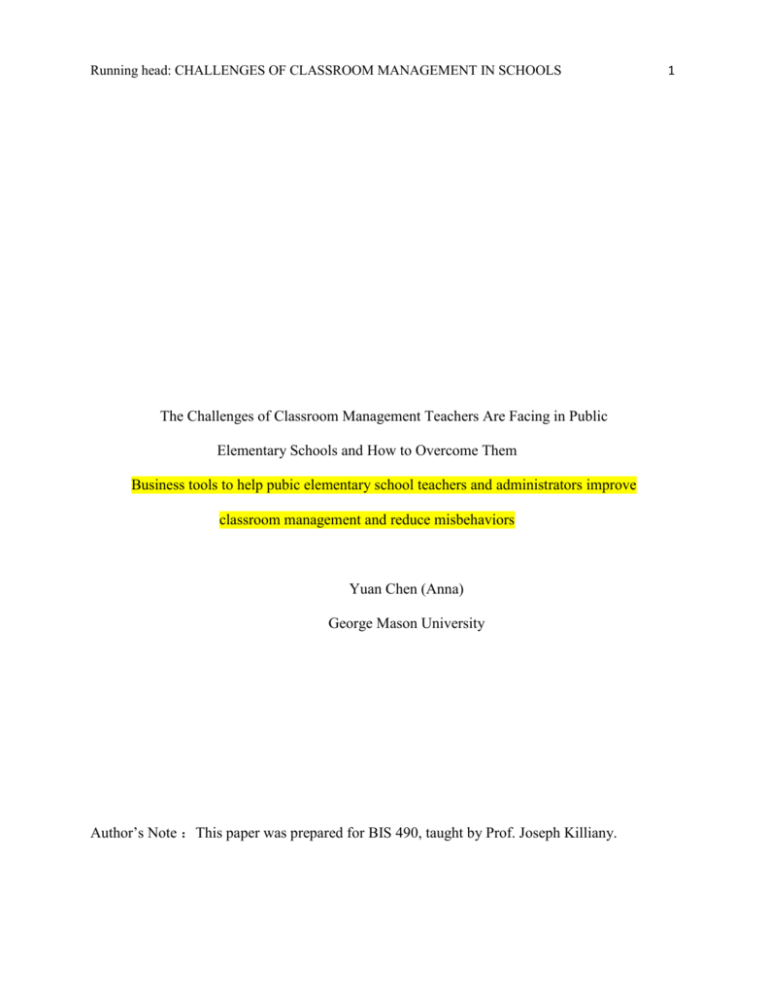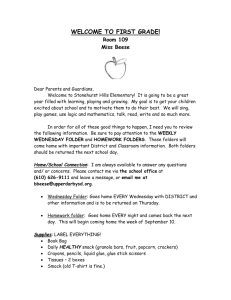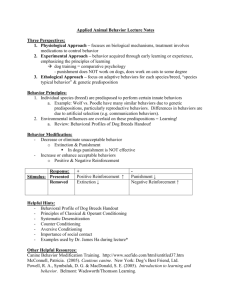491presentation111814
advertisement

Running head: CHALLENGES OF CLASSROOM MANAGEMENT IN SCHOOLS The Challenges of Classroom Management Teachers Are Facing in Public Elementary Schools and How to Overcome Them Business tools to help pubic elementary school teachers and administrators improve classroom management and reduce misbehaviors Yuan Chen (Anna) George Mason University Author’s Note :This paper was prepared for BIS 490, taught by Prof. Joseph Killiany. 1 Running head: CHALLENGES OF CLASSROOM MANAGEMENT IN SCHOOLS 2 This project is designed to investigate common strategies used by teachers, and the pros and the cons of different strategies. The goal of this project is to persuade teachers to acquire a set of positive and problem-solving strategies in their “toolbox” with the aim of utilizing approaches that serve student best for their benefit in growth. Additionally, this project seeks to illustrate how to apply business management concepts, such as SMART goals, KPI, and system thinking to improve the effectiveness of management both in the classrooms and in the schools. Brophy (1986) defined classroom management (CM) as “a teacher’s ability to establish, maintain, and restore the classroom as an effective environment of teaching and learning” (p. 182). A well-managed classroom is the foundation to flourish both teaching and learning. Saritas stated that “the quality of education largely depends on the quality of classroom management”. The key elements of classroom management are managing time and space, instructional strategies and student behavior (McLeod, Fisher, & Hoover, 2003). Behavior management is the most challenging of the three because teachers cannot predetermine when and what student misbehaviors occur. Often, teachers need to respond immediately without planning or delay. A number of survey studies indicate that teachers feel inadequately trained in behavior management (Buchanan, Gueldner, Tran, & Merrell, 2009; Justice & Espinoza, 2007). Let us ponder on two scenarios. Scenario 1: A student runs down the hall. Miss A said, “You know better than that! Stop running! Go back and show me how to walk.” On the other hand, on that same situation, Miss B responded, “Walk down the hallway, please.” When the student stopped running and started to walk. She commented: “I am so glad to see you walking down the hallway. I believe you can remember it next time. ” Scenario 2: After recess, all students were sitting on a carpet in a circle for a reading activity. A second-grade student threw a tiny piece of wood which it fell on the teacher’s right Running head: CHALLENGES OF CLASSROOM MANAGEMENT IN SCHOOLS 3 leg in the beginning of the activity. Miss A’s response was, “What’s wrong with you? Go and sit at your desk. I am going to tell your parents to discipline you.” The student was sitting at his desk for almost entire time of the activity. Whereas, Miss B’s response was, “It is not an acceptable behavior in our classroom. You cannot throw anything even this little piece of wood at anyone. I want to know why you did that. Let’s talk about this after the circle time.” The student sat in the circle to finish the activity. Later, they had a conversation about this incident. In scenario 1 and scenario 2 above, all strategies worked as intended to stop or change behaviors, but which strategies do you think worked better for the students? Which teacher handled the students’ misbehaviors more professionally? Common strategies for behavior management There are various strategies to handle misbehaviors in classrooms, for example, corporal punishment, suspension, yelling, taking away recess time, rewarding, praising, holding classroom meeting to solve problems, and other strategies. These strategies can be sorted into four categories: corporal punishment, punitive strategies, positive strategies, and problem solving strategies. Corporal Punishment (CP) still remains a legal form of discipline in 19 states, most of them in the South. According to an analysis of federal data from 2009-2010, the Children’s Defense Fund reported in 2014 that 838 children were hit on average each day in public schools. Data also shows that African-American students and students with disabilities are disproportionately subjected to CP in school (Strauss, 2014). Punitive strategies include suspension, expulsion, sarcasm, yelling, taking away recess time, and embarrassing students in front of others. Punishment is a procedure in which responses are followed by either the removal of positive reinforcement or the presentation of an aversive stimulus (Skinner, 1953). It seeks to stop unacceptable and unwanted behaviors. It became the Running head: CHALLENGES OF CLASSROOM MANAGEMENT IN SCHOOLS 4 treatment of choice for disciplining misbehavior children and controlling unruly students (Hall, 2013). Zero Tolerance (ZT) policies originally conceived within the criminal justice system. The term Zero Tolerance was first introduced into American public school in the mid-1990s (Evans & Lester, 2012), and it has been adopted by 94% of public schools (Skiba & Rausch, 2006). The original purpose to adopt this policy was to ban student use of drugs and alcohol, but “it has quickly expanded into a frenzy of punishment and tougher disciplinary measures in American schools” (Ayer, Dohrn, & Ayers, 2001, p. 259). A new report released in 2014, shows that “nearly 5,000 preschool students [were] suspended once, and [more than half of them] suspended more than once” (p.7) in 2011-2012 school year. Some researchers and critics question whether children in the early grades should ever be suspended. Punitive strategies would only temporarily stop students’ misbehaviors. However, such strategies disrupted the relationship between the teachers and their classes. Some research confirmed that punitive strategies are associated with more misbehavior among students. It also would be difficult for a teacher who wants to be more effective, if he frequently use harsh punitive strategies, since students normally do not willingly cooperate with him. NO one really benefit from these “negative” strategies in long-term. What are the alternatives? If punitive strategies are a reactive approach, then positive strategies are designed to proactively manage misbehaviors by teaching, recognizing, and reinforcing appropriate behaviors. If students know how to behave appropriately or they know how to release negative emotions, misbehaviors can be minimized in the lowest level in the classrooms. Positive behavior support (PBS) is very popular in recent years. PBS is rooted in Skinner’s behaviorist theory of behavior modification, which emphasizes behaviors that are Running head: CHALLENGES OF CLASSROOM MANAGEMENT IN SCHOOLS 5 valued. PBS is focused on the design of environments that promote desired behavior and minimize the development of problem behaviors (Dunlap, Sailor, Horner, & Sugai, 2009, p.4) It based on the idea of prevention. It purposefully switches teachers’ attention from punishing challenging behaviors to rewarding desirable behaviors. Problem-solving strategies are more focus on social and emotional learning. Advocates emphasized that problems provide the opportunity to develop problem-solving skills in a nurturing atmosphere that empowers students with the courage and confidence they need to be productive, contributing and happy in classrooms. solution-oriented approach – seek to understand what happened, what caused it to happen, what each person could do differently next time to keep it from happening, and how to make amends if needed. Functional Behavioral Assessment (FBA) is defined as “a process of identifying functional relationship between environmental events and the occurrence or non-occurrence of a target behavior” (Dunlap et al., 1993, p.235). The usefulness of FBA is based on the belief that behavior is purposeful and serves a function for a student. Today, the usefulness of FBA continues to grow across student populations with learning disabilities, emotional disabilities, autism, students at-risk, and even typically developing students (Gable et al. 2014). With proper training, FBA can help teachers deal with challenging behaviors more effectively. Classroom Meetings provide opportunities for students to express their thoughts and brainstorm the solution. Inviting students to explore the consequences of their choices is quite different from imposing a consequence on them. There is a huge difference between telling students what they need to do and asking them what the solutions are. “Telling usually creates physiological resistance in the body… respectfully asking creates a physiologically relaxation for the body… [They tend to] appreciate being involved, feel more capable, and usually decide to be cooperative” (Nelsen, Lott, & Glenn, 2013, p.19). It can also develop “self-discipline and self- Running head: CHALLENGES OF CLASSROOM MANAGEMENT IN SCHOOLS 6 control by thinking through the consequences of their choices and by accepting suggestions for solution form other students” (Nelsen, Lott, & Glenn, 2013, p.7). Some teachers believe that classroom meetings save teachers’ time and help them learn the skills they need to success both in academic and in life. Recommendation Many strategies are available for teachers to use for classroom management. Some teachers may feel overwhelmed by many choices, many priorities, or many challenges. So having some sort of management tool could help in these areas. One tool is about setting up goals to manage classroom. Goals could help a teacher cut through the clutter of a crowded mind and keep thoughts on the things that matter the most. SMART Goals SMART goals have been widely used as a management tool in government, industry, businesses, and nonprofit organization. It stands for Specific, Measurable, Attainable/Achievable, Relevant/Realistic, and Time-bound (Lee, 2010). First, specific goals should clearly define what you want to achieve, including detailed description of what, why and how. Second, measurable means the degree of accomplishment that can be accurately measured. It should be tangible and operable. Thirdly, achievable goals should stretch people’s abilities slightly so they feel challenged. On the other hand, if the goals are not reasonably achievable with respect to available time, talent, and resources, frustration is sure to follow. Forth, the goals must be relevant or realistic. When we try to solve an issue, we may need to prioritize possible solutions and choose the most relevant ones. Finally, goals should have a time-frame. A deadline helps people focus. Reduce procrastination. Key Performance Indicators & System Thinking Running head: CHALLENGES OF CLASSROOM MANAGEMENT IN SCHOOLS 7 Another valuable management tool is known as Key Performance Indicators or more commonly as KPIs which can also help teachers and administrators. Once goals are thoughtful selected, KPIs can be used to measure what truly matters to help you pursue and achieve the goals or results you want in your school. Parmenter (2007) believed that KPIs could tell you what to do to increase performance dramatically. Therefore, in order to make any improvement in classroom management, teachers and administrators should know what the KPIs are in a school and use KPIs to guide them on the road of champions. School administrators, teachers, and students are critical components of the whole educational organization and they are interconnected with each other. They are very much likes the legs of a three-legged stool, in which no one leg balancing by itself to match the degree of stability and each contributes to the fully assembled piece of furniture. System thinking is a way of helping a person to view system form a broad perspective that include seeing overall structure, patterns, and cycles in system, rather than seeing only specific events in the system. System thinking has produced a variety of principles and tools for analyzing and changing system (managementhelp.org). System thinking can help teachers to align their goals and professional development with the goals of the school. Conclusion Effective classroom managers tend to employ different types of strategy to different types of student, Effective classroom managers tend to use positive strategies and problem-solving strategies. IN ADDITION, Effective classroom managers combine time-tested, time-proven business tools such as SMART, PKI, and System Thinking to better manage their classrooms. Let’s put kids first. Let’s do what works to improve behavior in the school.







